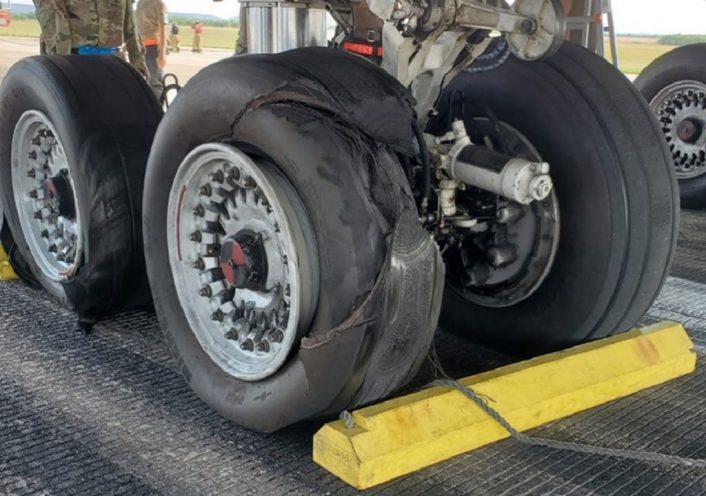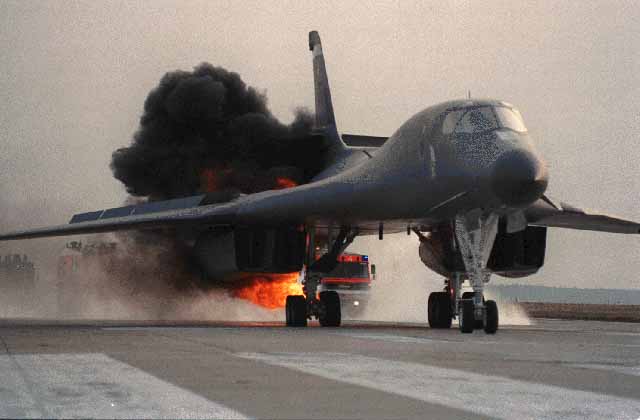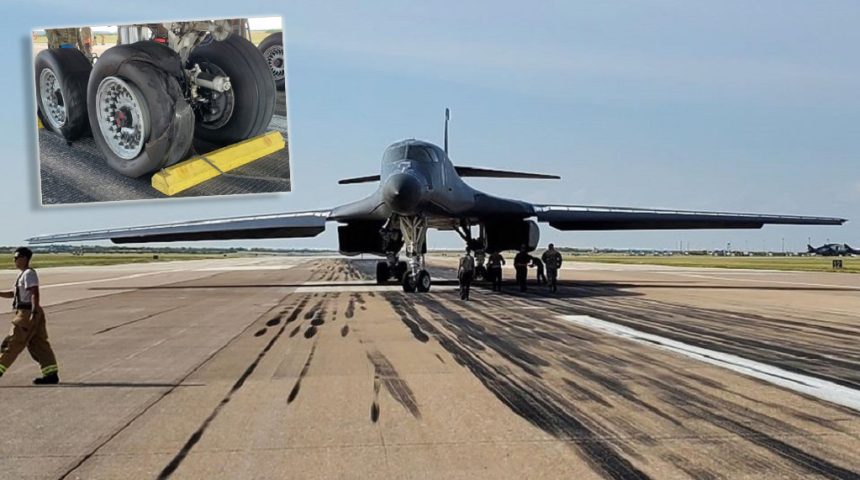While not officially acknowledged, photos of the aftermath of the incident emerged on social media platforms.
Some photos recently surfaced on social medias showing a B-1B Lancer bomber after an emergency landing. The photos sent by an anonymous source to @combat_learjet, who posted them on his social media accounts, were accompanied by a brief description of what happened.
According to the source, the “BONE”, as the B-1B is dubbed (from B-One), took off for a training mission and, about 30 minutes later, experienced an unspecified in-flight electrical malfunction that forced the crew to return to base for an emergency landing. The bomber reportedly blew two tires on landing and suffered a brake fire, but all four members of the crew were able to safely egress.
We couldn’t find any official reports of this incident at this time, so everything we can say is based on the photos and the description they came with.
From the photo of the bomber on the runway, referenced with older photos and satellite imagery, the incident may have happened at Dyess Air Force Base, with the aircraft photographed at the southern end of runway 16-34 near the 12,000-foot marker. Some of the elements that helped the identification of the air base are the color of the runway’s pavement, the glideslope antenna on the left and some other B-1s on right edge of the photo parked perpendicularly to the runway.
The Bone blew two tires, which from the photos seem to be the outer tires of the left main landing gear. Considering the tire damage and the brake fire reports, it could be safe to assume that the aircraft, due to the emergency, performed an overweight landing putting more pressure on the landing gear and the brakes, resulting in the two tires blowing and hot brakes that could have caused the subsequent fire.
Another interesting thing that has been noted is that some of the tires are made by Michelin, others by Goodyear.

Without an official report, we can’t say how accurate are these considerations. However, the most important part is that the four crew members escaped without any problems on the ground. As you may remember, about two years ago, one of Dyess’ bombers suffered a failed crew ejection after an engine fire, forcing the aircraft to perform an emergency landing that resulted in the four crew members being awarded the Air Force’s Distinguished Flying Cross.
The B-1B bomber fleet has been plagued by many problems lately because of aircraft wear after flying countless missions which it wasn’t designed for, as we wrote in a previous article here at The Aviationist:
The problems of the B-1B Lancer raised quite a few concerns lately, with the entire fleet grounded twice for mechanical issues in the last year. In June 2018, a safety stand-down was issued after the failed ejection of the crew following a serious engine fire, while in March 2019 the fleet was grounded again for nearly a month because of an issue with the drogue chute discovered during a routine inspection of the ejection seat. Another potential problem could derive from the fact that the B-1 was long used for a mission it wasn’t really designed for, Close Air Support, which included slow flying at high altitude with its wings swept forward while waiting to be called in by troops on the ground. That type of flying is said to have caused too much stress on the wings, wing roots and sweep mechanism. All the aforementioned problems contributed to the drop of the readiness rates to just over 50 percent in 2018.
After a slight improvement in the situation, the bombers started participating in numerous Bomber Task Force missions in the Pacific Ocean area and Europe, integrating with allied air forces and sometimes carrying/simulating JASSM and LRASM missiles. The U.S. Air Force is also planning to add the AGM-183A Air-launched Rapid Response Weapon hypersonic missile to the B-1B inventory, carried under external pylons.
The Aviationist’s Editor David Cenciotti would like to thank his friend @combat_learjet for providing the photos you can find in this article. Make sure you follow him on Instagram and Facebook.
Update:
Interestingly, as pointed out by our friend @vcdgf555, a B-1 landing at Rhein-Main airbase in Germany in 1994, suffered a hard landing, blown tires and brake fire. Here’s a photo posted on Wikipedia:










